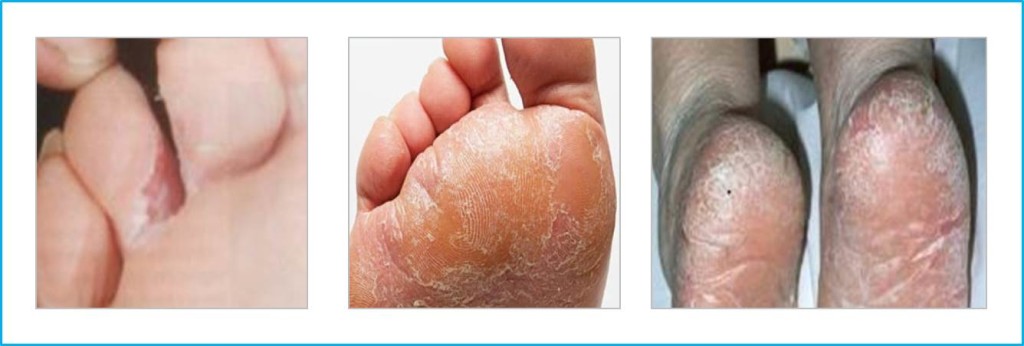What is athlete’s foot?
‘Athlete’s Foot’ is the common name for Tinea Pedis.
This is another common fungal infection, as indicated by the name, most often affecting the feet but can be found on the hands. It is also caused by dermatophytes. Candidal infection may also produce similar symptoms but is less common.
These infections are typically transmitted in moist, communal areas, such as: showers, pool-side, or in changing rooms, by walking barefoot in an infected area. It happily incubates in closed (occluded) footwear, creating the types of symptoms you see below:
How do I know if I have it?
Are you aware of the following:
- Scaling skin on the soles or sides (or less often, top) of the foot
- Tiny blisters, usually itchy, that do not ‘pop’
- Peeling skin, particularly starting between and just under, the toes
- Skin appears white when damp or wet, is unusually easy to remove
- Fissures/splitting of the skin, deep for appearing so quickly, most often between toes and on the lower side of the ball of the foot
Who does it affect?
Anyone can be affected and fungus proliferates in warm, moist conditions.
‘Athlete’s Foot’ is so-called precisely because so many sportspeople are affected by this notorious condition. The reason for this is two-fold. The first is well known: hours spent training meaning feet are sweating in enclosed shoes, creating the moist, warm environment perfect for fungus to flourish. However the second, is less known: engaging, for a little over an hour, in high-intensity or endurance training means your body quickly shuts down the immune system to maintain the required level of physical activity. This allows quick-to-flourish infections, such as tidea pedis, to take hold in short order.
It is also why those who undergo immune-suppressing treatment, such as chemotherapy, see a very rapid spread of any fungal infections.
You don’t have to be an athlete or regular sportsperson to contract these infections. Ways of contracting and incubating these fungal microbes:
– spread from close proximity to another sufferer
– walking unprotected in infected communal changing rooms, particularly at swimming pools. If you’re in these environments often, it is a good idea to protect your feet, by wearing plastic sandals or flip-flops
– only wearing one pair of shoes to work or to train. Having at least a couple of pairs of shoes for your regular activities gives them time to air dry between wearing
– wearing synthetic shoes all the time. Only wearing closed-toe, synthetic, shoes creates the ideal environment for fungus to grow. Leather or other breathable materials and open-toed shoes are much more healthy for your feet
– wearing synthetic socks or pantyhose, or hands encased in training gloves (for instance, those who box or fence regularly). These coverings create dark, damp environments with restricted air-flow, in which fungus thrives
Again, the occurrence of these infections increases as we become older and men suffer at least twice as often as women.
The usual complications from athlete’s foot are onychomycosis or cellulitis (bacterial infection which enters through broken skin caused by the fungi).
Those with restricted or limited mobility, impaired circulation in the extremities or on immune-suppressant medication or treatment often battle with the problem of fungal infections.
You are not alone
It is estimated that over 15% of the population suffer from tinea pedis. That means nearly 10 million people in the UK have this problem, right now. For most, it’s an unsightly, sometimes itchy, intermittently painful, but generally easy-to-ignore problem once closed shoes are put on.
It spreads easily, but if caught in the early stages with a topical treatment and keeping the feet aired as much as possible, can be controlled.
Once this has taken hold and the spores are found in the tissues, it is very hard to eradicate and it requires diligence and consistency with any elimination regime undertaken.
Let us help
These infections can be brought under control. It requires weekly sessions, conducted simply and painlessly, plus, the use of one or more products being used at home. Commitment and diligence are required to get rid of the infection/s and heal the areas where symptoms were visible.
We have been successfully allowing others to get healthy feet again. Let us help you.
This may be combined with nail treatment & we have special prices for the combination treatment.
Call us today and have clear, healthy, supple skin AND nails!

